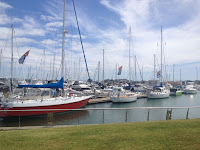[Kyle]To break up the ten to twelve day passage between Nuku'alofa in Tonga and New Zealand, we stopped for a rest of several days, about a quarter of the way, at a shallow enough spot in the ocean to drop anchor known as the Minerva Reefs.
Minerva consists of two coral reefs separated by about twenty miles lying just south of the Tropic of Capricorn and just east of the Antimeridian (the 180 degree longitude separating east from west). The reefs' name comes from a whaling ship that ran aground on South Minerva in 1829. The Ship's name comes ironically from the Roman goddess of wisdom.
Shipwrecks are still common on Minerva, although slowly becoming less so because of GPS and more accurate charting. Most notably was Tuaikaepau, a 51 foot Tongan vessel carrying a whopping seven crew and ten passengers who wrecked on South Minerva in 1962. Of course this was in the days before GPS, where unfortunate weather can leave any boat with only an approximation of their position. The crew and passengers of Tuaikaepau survived in the hull of a Japanese fishing boat that had wrecked two years earlier. The Japanese boat had a still for making fresh water and they burned pieces of Tuaikaepau's wreck to keep the fire going. After three months, they built a raft without the use of tools, using some of the remaining wood from their wreck .The Captain, his son and a carpenter then set sail for Fiji. They arrived after seven days and capsized in the pass off the island of Kadavu. They swam for shore, but the Captain's son drowned before he could make it. Three others back on the wreck on Minerva also died before the group was finally rescued by a Royal New Zealand Air Force flying boat. {Maryanne: If you wish to know more there is an out-of-print book about this amazing survival story: Minerva Reef by Olaf Ruhen}
We chose to anchor at North Minerva because it offers better protection from the ocean swell and because the pass and lagoon are less tricky to navigate.
Since New Zealand lies outside the tropics in the band of climate dominated by the westerlies, its weather is dominated by the regular passage of alternating frontal systems and high pressure waves. A passage to New Zealand must be timed carefully in order to make best use of the shifting winds and to avoid being caught out by a storm. Since most forecasts rapidly drop in reliability after five days or so, any ocean passage longer than that has no choice but to set out with a good forecast and then adjust the plan as you go. A stop at Minerva offers the strategic advantage of being able to break the Tonga – New Zealand passage into two separate legs. This makes it possible to leave Minerva at just the right time in the frontal cycle and to have a weather forecast in hand that offers predictions all of the way until landfall.
Because of this, almost all sailboats making the passage between southern Tonga and New Zealand make the stop at Minerva to regroup before continuing on. A stop also allows yachts to confer with each other about weather and strategy. It is also a great last chance to swim and clean the boat hull before entering New Zealand waters.
Our trip to Minerva started at first light the day after clearing out. A day earlier would have been ideal, but Customs was closed then, so we had to make use of as much of what remained of the window as we could. The wind angle was such that we were just able to avoid tacking as we made our way through the shipping channel from Nuku'alofa to the sea. Once there, we furled all of the sails, slowing us to a crawl. A little more running around and FOOM! The spinnaker billowed to life and we shot downwind across the open sea toward Minerva.
We had the spinnaker up for a day and a half before the backing wind went too far forward to make use of it anymore. We switched back to normal working sail and let the wind bend our course from southwest to south. We were approaching a frontal boundary and our goal was to get south of North Minerva's latitude before the southeast winds behind the front arrived, then we could make a big right turn and follow them to the atoll.
As the front approached, the wind shift brought with it lowering clouds and eventually pouring rain. Our pleasant downwind sail became significantly less comfortable. For the first time since reaching the southern hemisphere, we were each spending our night off-watches sleeping under a comforter.
The front passed. The pressure began to rise, but the predicted wind shift was taking its time in coming. By noon on our third day, we were close enough to North Minerva to motor the last few miles. That would allow us to get in just before dark and save us another night at sea. Once we had an engine running at cruising rpm, we realized we were fighting a big current that was eating up more than half of our speed. Our new ETA was hovering around midnight.
The wind picked up a little and with the help of the sails, we were able to speed up enough to get us there in daylight. A little further on, the current we had been fighting swung around and we were back to a comfortably mid afternoon arrival. Whew!


An uneventful passage to Minerva - you can 'just about' see the surf of the reef in the second picture
We spotted the breakers outside the reef about five miles out. We could also see a boat anchored on the inside. It took us a while to sail around to the pass on the far side and then make our way back to the windward side of the lagoon. We dropped anchor in four meters on the sand shelf about a half mile from the other vessel. We called them on the radio to introduce ourselves. They were an Australian couple who were looking at leaving for New Zealand in a day or two before the current weather window closed. We had considered doing the same ourselves, but we wanted to stay long enough to have at least a couple of decadent sleep-ins and do some exploring before making what is historically a pretty cold, stormy passage to New Zealand.
After downloading the latest forecast the next morning, we saw that the current weather window was predicted to close within the week. If we left that afternoon and sailed pretty fast, we could just make it before the wind shifted against us. We were ready to go, but neither of us had the motivation. We decided to take our chances and stay in Minerva until the next weather window opened, hopefully less than a week later.
That left us free to jump in the water and have a look at the place. We swam from Begonia to the inside edge of the reef and then followed the wall around for half a mile or so. There were a few things that were different between Minerva and Beveridge. Minerva seemed to have fewer sharks, a larger variety of fish species and many more urchins. The colorful clams are getting bigger than further east. The reef itself is also a little bit higher. It dries out almost completely at low tide, making the lagoon look like it is ringed with a big hundred meter wide sidewalk.




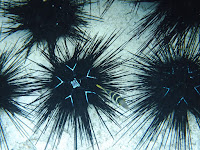


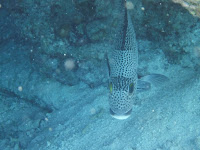




A look about the south side of the reef
there were huge numbers of spiny urchins tucked under the shelf, and plenty of fish and sharks to entertain us
As we swam, three other boats arrived and anchored on the other side near the pass. Two had been anchored with us at Big Mama and left the day after we did. We called those two up and found out they were only planning to stop long enough to swim in the pass before leaving in the current window. The Australians pulled up anchor. We thought they were going to leave, but then they anchored about the same distance on the other side of us. They said they were going to wait one more day, but the reef was a bit lower where they had been, making it pretty rolly there. They wanted a good night's sleep before leaving.


Kyle FINALLY! gives up early on the hair experiment and shaves it all off
The next morning, we moved too, not because of the swell inside but outside the lagoon. Upon recommendation of the two boats that had anchored near the pass, we decided to do some snorkeling on the outside of the atoll. Low tide was in the morning, so we found a spot on that side to anchor for the night. We were exposed to waves that had rolled all of the way across the atoll to get to us, so we had a pretty bumpy night, but the breakers on the other side of the coral had gone from eight to two feet.
As we motored over to the north of the atoll, two of the other boats plus the Australians left. We anchored near the third boat, but never could reach them on the radio. We woke at first light and by the time we surfaced and had a look outside, they were already outside the pass with their sails up. It was just us left on Minerva.
We swam quickly to the reef, climbed on top of the wall and splashed our way in ankle-deep water to the outside. We found a spot out of the swells at a crevice leading toward the sea, hopped in and followed it out. On the outside, the wall of coral dove away into empty blue and then black. We found several large schools of fish forming streams that undulated over the steep topography of the reef. Several species of reef shark patrolled in the depths just at the limit of the visibility. When they would spot us, they had the unnerving habit of bolting right at us to see what we were. One little guy was getting a little too curious and was following Maryanne closely. It was looking like she was going to have to punch him in the nose to discourage him, but he left when she wound up.
We found a great spot where the coral plunged vertically into the dark. Several species of fishes were congregating there, so we spent a while paddling against the current just enough to stay still, watching all of the mini-dramas of their lives once they became comfortable enough to ignore us.




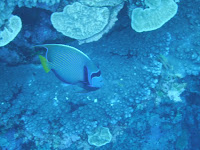

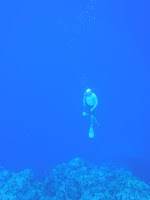


A great snorkel on the outside wall of the reef
Because we were on the deep water side of the reef in the Pacific, rather than the atoll, we were making a point of keeping closer together than usual. We were paying careful attention to both the current and the wave height for fear that our route back would get cut off and we would be forced to find a new route further on. After spending a few minutes at the wall, I noticed Maryanne kept disappearing. When I popped my head up to look for her, all I would usually see was a big wave about to hit me in the face. Every now and then, our crests would line up and I would see her head fifteen feet away. The underwater scene was the opposite. I'd lose her in the crests until I spotted her fins above me sticking below the water's surface. Fortunately, it was easy for me to dive down far enough to see her silhouetted against the sky. We decided it was time to head back.
We had no problem following the landmarks of the reef back to our entry point. We were lucky to spot two sea turtles swimming lazy circles along the way. The tide had begun to rise and conditions were a little rougher, but we got back on top of the reef with no problem for the walk to the inside. While conditions inside were way better than where we had been, our anchorage was starting to get a little rough, so we decided to return to our original spot in the lee of the reef on the east side.
Before we did, though, we made a detour to the pass where we each did a drift snorkel in turn while the other loitered nearby in the boat. The coral wasn't as interesting, but there was a nice concentration of larger fish. When I went in, I was immediately surrounded by big schools of grouper and tuna. Oh, and sharks – lots of sharks. They were milling around way down at about 20 meters. I tried a couple of times to dive down close enough to get a better view of them, but as soon as I submerged, they all scattered like flies. Scaredey-fish.
After drifting for a bit, the scenery started to drop off so I headed back toward where Maryanne was hovering with Begonia in the deep water at the middle of the pass. It started to rain pretty hard then, which didn't bother me as I was already wet, but Maryanne said it was getting harder and harder for her to see me. Luckily Begonia is way bigger than my head, so I was able to find her.
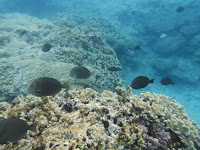

The walls of the pass were less spectacular than the walls outside of the reef, but WOW, there were plenty of sharks in the middle of the pass.
Just before I arrived at the boat, I did a few last pirouettes to take in the view before climbing out. Behind me were about twenty sharks all following me. As soon as I was facing them, they all did this hilarious routine where they would scatter in all directions like they just happened to be there by coincidence and totally not following me at all in any way. I would swim some more, turn to find twenty faces full of teeth and they would do it again. It was like one of those mobster movies where the tail is completely terrible at tailing someone inconspicuously. I managed to get back aboard without getting whacked and Maryanne took us back to our old spot.
We were all alone at North Minerva for another day and a half, all of which was gray and rainy. Being encouraged to stay indoors by the weather gave us the chance to get everything aboard better organized. New Zealand Customs will definitely be coming aboard when we clear in and confiscating anything from a long list of things they don't like. We'll eat as much as we can of that before we get there and have anything questionable where it will be easy for them to inspect. Maryanne was getting experimental with the cooking to try and use up forbidden food stocks.
Our solitude was broken by the arrival of a very nice British single-hander named Michael. We had a lovely chat on the radio but he had a few things to fix and was understandably keen to get in a good long sleep. I imagine that will be in reverse order. We left him to it and went back to resume our scrubbing.


A surprise visitor (black bellied plover) and some beautiful sunsets
